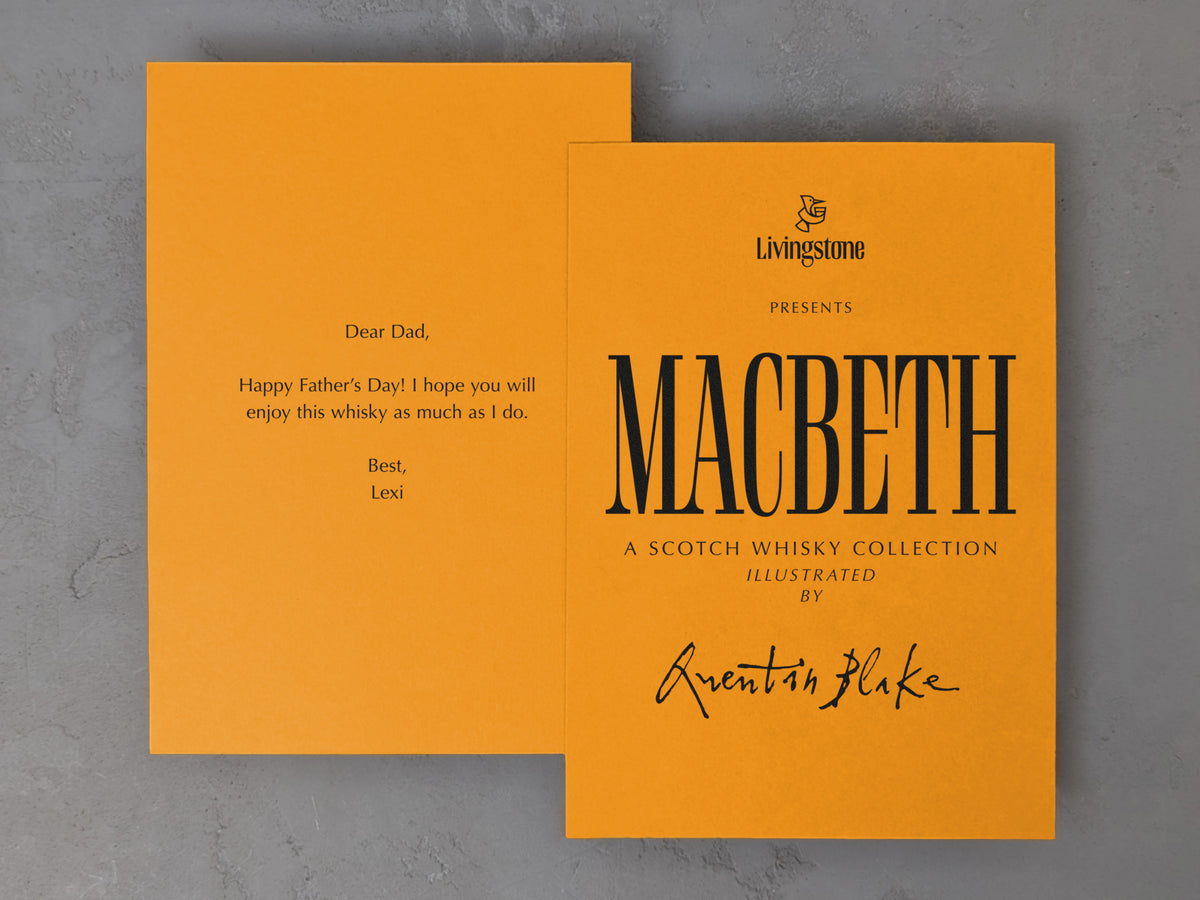
How did the idea for the Macbeth collection come about?
I have worked in whisky, on the design side, for a long time. Over the years, I’ve grown increasingly fascinated and read extensively on the industry, absorbed by histories of distilleries and the people around them - stories of allegiances and collective endeavour, but also ruthless ambition and intense rivalries. I thought “this is just like Macbeth”.
And that was it. The whole structure appeared in that one moment; the most famous Scottish play full of fantastic characters from across Scotland, bright to dark, light to heavy, from every class and realm, at different ages, all waiting to be cast as Scotch whiskies. And the fixed number of characters meant the series would be finite – key to creating a meaningful collection. The series within this were already formed, both in terms of characterisation and price: The Leads could be scarce single malt Scotch whiskies of great age, noble whiskies of around 30 years old to represent The Thanes, and the play is full of Ghosts, perfect for silent, ghost distilleries. The Witches are the world’s most famous blenders, and The Household – a porter, doctors, messengers – are ideal for characterful whiskies available in greater numbers at a more accessible price. The whole structure worked. And by releasing one or two bottles from each subset at the beginning, anybody interested in collecting them can see what the prices are and pick a lane.
The best thing is, people know the characters, and have opinions about them. This project changes the way you think about the drams. Rather than being “is this a good example of a such and such bourbon cask” it’s “is this Banquo?”, which is a more entertaining conversation.
Can you tell us about the partnership with Elixir Distillers?
Macbeth needed not only one, but 42 whiskies, from all over Scotland, at different ages and rarities; it was a massive ask, one that very few companies could undertake. I sought an introduction to Elixir Distillers, without whom the project would not have happened. I met with co-founder and owner Sukhinder Singh and head blender Oliver Chilton and showed them the idea, and some of the drawings. I was nervous about it, as their opinion meant a lot to me – I knew Elixir well via their independent bottlings, which I’ve always found impeccable, but also through Sukhinder’s reputation as a collector, and as someone who genuinely loves whisky. In that regard Elixir Distillers is unique; as whisky makers, whisky collectors, and whisky drinkers, they represent both
sides of the equation at the highest level.
Beyond that, I knew Oliver and Sukhinder had tasted a vast number of whiskies from all around Scotland at many different ages, which felt vital for being able to fulfil Dave’s character descriptions; you need to know where to look. I was thrilled when they said yes. The whiskies Oliver selected felt magical; we went through them together, and almost all the first releases were agreed there and then.
How did Sir Quentin Blake come to illustrate the characters?
Sir Quentin Blake was one of my first clients and I’ve been fortunate to design books and exhibitions with him for over 20 years. He’s an extraordinary person - 90 years old and still drawing all day, every day. Obviously I wanted Quentin to illustrate the characters. He showed limited interest, until I suggested drawing them as birds. Quentin, who has been drawing anthropomorphic birds for decades (one of his books, Birdland Theatre Workshop, has birds as actors in Shakespearean scenes) rang me the following morning to say he had woken at 4am and completed a set of rough drawings in bed. It was one of the most exciting moments of my working life.
And Dave Broom? What is his involvement?
Dave drew up the character descriptions for the whiskies to guide their selection and has subsequently written character notes for each of them. Once I had a few of the completed drawings, I knew they were just too valuable for it not to happen. I also felt a strong sense of responsibility to not under-deliver, and that meant I needed somebody with an encyclopaedic knowledge of Scotch, who knew the play inside out, and could also actually write. I met with Dave, told him how much I’d enjoyed his books, and asked if he knew much about the play. When he said that he’d already created his own production of Macbeth at home, with a cast of hamsters, I realised I was talking to the right person. I gave Dave the outline structure and the illustrations, and asked him to write profiles for all the characters. Not as specified distilleries and ages, but as whisky character descriptors. He soon came back with an overarching plan that the dark forces in the play should be represented by smoke: thick and heavy for The Murderers, becoming older and more sophisticated with The Witches, until it reaches its apex in the master manipulator, Lady Macbeth. That’s not to say there isn't some smoke within other characters - the play is full of ambiguities - but as an overall shape it worked very well. Beyond that he worked into each individual character in depth, eventually providing me with a paragraph on each.
How do you feel about Act One, the first nine characters, now it's released?
It’s a testament to the play. We felt an enormous responsibility to live up to its quality and power, and I see the evidence of that hard work in the extraordinary whiskies selected by Elixir Distillers, the eloquence and precision of Dave Broom’s character notes, and in the illustrations by Sir Quentin Blake, who somehow makes everything look effortless.
























